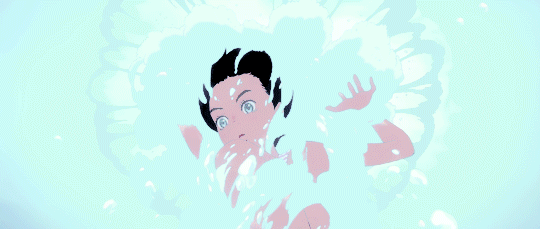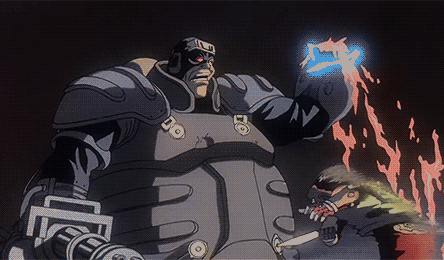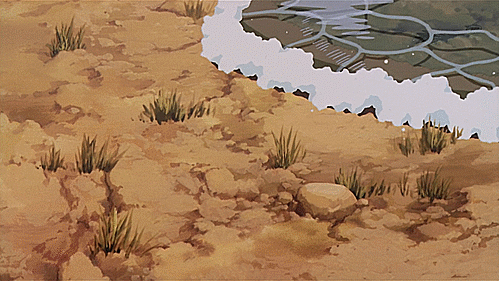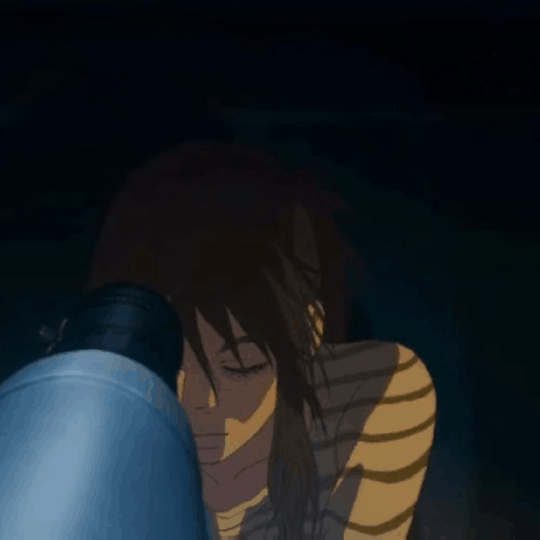originally posted at https://canmom.tumblr.com/post/664409...
Hi friends, welcome to Animation Night! Today’s been a bit of a slow day so I hope you’ll forgive me kinda hasty writeup.
Tonight, we’re going to return to Studio 4°C, who made many of my favourite films from Animation Nights past: Tekkonkinkreet, Memories, Mind Game, five parts of the Animatrix, Ani*Kuri 15, Genius Party, Digital Juice as well as animation work on Birdboy: The Forgotten Children… and that selection probably gives you a hint at what their deal is: experimental, arty, sakuga rich, sometimes kinda edgy lmao.

4℃ (the name referring to the temperature at which water attains its highest density) was founded in 1986, by producer Eiko Tanaka (who worked as a line producer on Ghibli films including Totoro and Kiki… the chronology is kind of odd here, since those Ghibli films came out in the 90s) and the incredibly stylish animator Kōji Morimoto, formerly of Madhouse. Morimoto’s in most of those anime short film collections I like so much, and consistently makes some of the most striking and vivid entries, especially when he came into his own at 4℃. As to why Morimoto left Madhouse to found his own studio, I can’t really say - the 80s were a pretty high point in Madhouse’s run.
I’d love to be able to dig in more to the background of this studio, but sadly it’s hard to find much information in the time I have beyond lists of films they’ve made. So let’s try and make a story out of those…

Presumably their first few years would have been spent providing services for other studios, since their first works don’t appear until the 90s, starting with two segments of the Memories compilation in 1995 (Animation Night 3… that brings me back). Within a few years they dropped their first feature film, Spriggan (1998), a cyberpunk-adjacent spy story overseen by Otomo and still renowned in sakuga circles for a brilliantly animated back alley chase sequence. (If you followed my links on the cinematism/animetism thing, you may remember this discussion about the different ways it constructs space).
They continued to make music videos and OVAs for the last few years of the 90s, many of which we’ve seen and one we haven’t (Morimoto’s Eternal Family), but things really seemed to take off in the 2000s with a whole series of short film collections. But tonight we’re going to focus on their feature films, and the next notable one here is Princess Arete (アリーテ姫 arīte-hime, 2001), which caught my attention recently thanks to a video by animator Dong Chang. Coming at the tail end of the cel era and thus rich with beautifully painted backgrounds, Arete tells the story of a fantasy princess who is kidnapped by a wizard who attempts to mind control her into submissiveness, and her struggles to throw off his control. So it’s a feminist parable about self-determination… but it sounds like it has more to it than being overtly didactic, with a beautiful and melancholy atmosphere.

4℃ continued filmmaking through the 2010s; in addition to the films mentioned above, we might mention a sequel short to Tamala 2010: A Punk Cat in Space and Harmony (2015) with Michael Arias of Tekkonkinkreet fame.
In 2019 we hit Children of the Sea (海獣の子供 kaijū no kodomo), and this is where we reach a very unfortunate chapter. Children of the Sea is widely named a film which captures the beauty of the sea so well it is almost impossible to describe, as Natasha ‘Illgenes’ writes:
Children of the Sea is easily one of the most stunning things I have laid my eyes on. It’s messy, dynamic, poetic, and a momentum of expressionism that I’ve rarely experienced on a big screen. Barring the unfortunate work ethics involved with the creation of the movie, there is really nothing I can put into words that describes how ephemeral this film is: as the director Ayumu Watanabe said himself, it’s a movie to be felt and seen, rather than truly deciphered and understood.
Rarely have I felt so overwhelmed by the bizarre beauty of the sea, the emotional waves of turbulent youth, and of the vast and inexplicable force we call nature that surrounds us. It’s this kind of immersion that makes me appreciate the medium of anime, and equally, it’s a testament to the careful balance of both hand-drawn animation and CG.

…but achieving this involved taking the already miserable conditions faced by anime production assistants to such an extreme that the studio actually ended up unable to win a lawsuit. kVin writes, in an article about inbetweeners:
When we interviewed many production assistants to shed light on what’s another of the worst positions in anime, it became clear that they’re looked down upon even among their peers; they’re not real creators, even though the second most common route to becoming a director is precisely through production assistance. We’ve continued to see that feeling weaponized from above in the most malicious ways in cases, like the studio 4ºC production assistant who sued the studio over the near-slavery conditions he had to endure during the production of Children of the Sea. The studio succeeded in dividing the workforce and essentially pitted veteran artists against these overworked management staffers—and as of yesterday, we know they lost the case pretty spectacularly. The labor victory comes with so many caveats that it’s hard to rejoice about it, but seeing this strategy fail for once is comforting.
It’s… honestly really tragic that a studio that has made some of my favourite works of animation could be responsible for this kind of malicious workplace abuse, though too easy to believe. (After all, Madhouse, the studio’s ‘parent’ in the grand lineage of anime, have also been implicated in a similar case, bad enough to bring in the ‘Black Companies Union’). Of course, the individual animators who made this film aren’t necessarily responsible for the conditions but more likely to be victims as well; yet it’s certainly a black mark for Morimoto as co-owner of the company that this could happen, and a deplorable lack of solidarity that the animators could be turned against this PA. Not to mention immensely hypocritical given the themes of so many of their films. But bosses will be bosses.

Nevertheless, without conveniently forgetting the miserable circumstances of its creation, I still wish to absorb this spectacle, so Children of the Sea’s on our list for tonight! To actually talk about its contents, film tells the story of a girl who meets two strange boys ‘raised by dugongs’ at an aquarium, and gets drawn into a lot of splashy and wet supernatural events.
Which means we’re probably going to have quite a variety of vibes, united merely by the shared staff who return on each of those films across a span of more than two decades. Since that’s quite a program, I’ll resist the temptation to pad it out further with more of their shorter works: we’re watching Spriggan, Princess Arete and Children of the Sea.
I would like to say we will start now, but I’m still downloading one of our movies, so instead we’ll have to begin in about an hour (8pm UK time), at twitch.tv/canmom. In the meantime I’ll warm us up by trying to finish my current animation project (spoiler alert: there’s no way I’m getting that done in an hour lol).
Spriggan: very fun, incredibly rich animation, in service of what is by now a pretty rote tropey plot alas. Visually, it does a lot to call to mind Akira, but it doesn’t quite reach that level of feeling hehe. But the chase sequence was indeed as good as advertised, as were a number of really impressively choreographed fights, full of bananas good solid drawing and effects animation of smoke torn by bullets and crumpling metal. It is very recognisably in that idiom of 90s high profile cel animation with Ghost in the Shell and Millenium Actress, with a lovely colour palette and incredibly precise realism-oriented character designs. And I can see why it was picked for the animetism-cinematism discussion, since a lot of shots make quite interesting use of painted ‘book’ cels to approximate camera moves.
Princess Arete turned out to be the real treasure of the night: I admit my initial reaction to the plot summary was skepticism - after how worn out princess stories had become I was afraid it was just going to be a kind of rote ‘did you know girls can do stuff’ story. But I shouldn’t have doubted Sunao Katabuchi: it definitely has something of the same melancholy but hopeful feeling as In This Corner of the World. Certainly it is a fine work of Anti-Wizardischte Aktion, with its orphaned atlantean autocrat too lost in his vision of an unattainable past to appreciate any of the present possibilities of life once he’s forced other people to take care of the necessities; certainly he is happy to essentially lobotomise the MC and lock her in a jail cell, as misogynist wizards are wont to do; certainly her family see her much more as an object who’s supposed to go through the motions and find an eligible suitor; yet this all fits into the film’s broader theme of like, connection to the world and finding or rather creating meaning. It was very beautiful and well put together; given Dong Chang recommended it alongside the extremely stylish and striking Metropolis (Animation Night 53), I’m v much looking forward to his third rec, Maquia: When the Promised Flower Blooms.
We did not have time to get to Children of the Sea in the end, so I’m planning to do a supplementary Animation Night tomorrow rather than keep you all up past 2am. Still very much looking forward to that one.
Comments